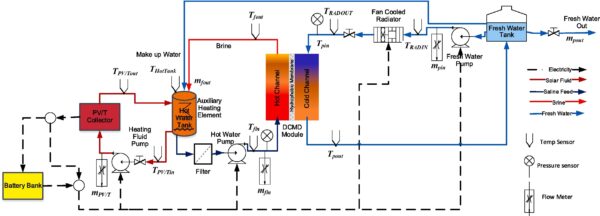Researchers from Australia's Commonwealth Scientific and Industrial Research Organisation (CSIRO) Manufacturing have developed a novel off-grid direct contact membrane distillation (DCMD) system that runs on photovoltaic/thermal (PV/T) panels.
The proposed system is intended for desalination applications in remote areas.
“The modular and adaptable design aims to provide a practical off-grid solution suitable for regions with limited water and energy infrastructure access,” said the team. “It can offer an energy-efficient for potable water production in areas where access to fresh water and power infrastructure is limited.”
DCMD is a type of membrane distillation process (MD) where both sides of the membrane are in direct contact with water. In both DCMD and traditional MD, salty or dirty water is heated, creating vapor that passes through a membrane, trapping the impurities in the hot feed side of the system. On the other hand, on the cool, permeate side, cold conditions cool the vapor and turn it back to liquid water. The “direct contact” part of the system refers to the fact that both the hot and cold sides are in direct contact with the membrane.
The experimental setup is based on a lab-scale DCMD module with an effective membrane area of 0.008 m2, using polytetrafluoroethylene (PTFE) membrane with a pore size of 0.22 μm or 0.45 μm. The PV/T panel has an electrical output of 375 W and a thermal output of 660 W. The electrical output is used to power a 12 V pump that circulates water around the system, two DC fans of 100 W each to cool the freshwater that serves as the coolant on the cool side, and a 12 V battery backup.
“Feed water was circulated through the back sheet heat exchanger (HEX) of the PV/T panel, elevating its temperature to a range of 40-70 C at the feed inlet of the MD system,” the researchers said. “The PV/T panel accommodates 5 L of circulating heat transfer liquid. To maintain a constant salinity level within the feed tank, freshwater is pumped from a 5 L permeate water tank.”

Photo: CSIRO Manufacturing, Solar Energy, CC BY 4.0
In the lab experiment on the system, an AC electric heater was used to maintain a consistent bath heater temperature of 60 C and a feed tank temperature of 52 C. The outdoor experiment took place during two weeks of the Australian summer. In the first week, the scientists used a membrane with a pore size of 0.22 µm, while in the second, they used 0.45 µm. Average ambient temperatures of around 29 C and 36 C were observed during the first and second trials, respectively. Solar irradiance fluctuated significantly between 100 W/m2 and 1300 W/m2.
“The outdoor trials' fluctuated environmental conditions led to inconsistent operating temperatures, as through outdoor trial coolant inlet temperatures ranging from 22 C to 38 C and feed inlet temperatures between 40 C and 50 C, compared to more stable conditions in indoor trials (22 C for permeate inlet temperature and 55 C for feed inlet temperature),” the academics said.
The recorded average permeate flux in the outdoor experiment varied between 8-16 kg/m2h outdoors, compared to 22-30 kg/m2h indoors. Flux refers to the rate at which purified water passes through the membrane. The average system-gained output ratio (GOR) was calculated to be approximately 0.60 during the first trial and 0.66 in the second trial. GOR measures how effectively the thermal energy input is utilized to produce clean water.
“The system's power consumption was measured at 130-140 W, about one-third of the PV/T power rating, while the maximum power generation was 280 W in battery charging mode,” they stressed. “The thermal and electrical efficiency ranged from 10-18 % and 15-20 %, respectively. The cooling effect of the PV/T panel was measured between 1.5 C and 2 C, resulting in a marginal electrical power enhancement of approximately 0.8-1.2 %.”
All the details on the system can be found in “Sustainable desalination through hybrid photovoltaic/thermal membrane distillation: Development of an off-grid prototype,” published in Solar Energy.
This content is protected by copyright and may not be reused. If you want to cooperate with us and would like to reuse some of our content, please contact: editors@pv-magazine.com.



By submitting this form you agree to pv magazine using your data for the purposes of publishing your comment.
Your personal data will only be disclosed or otherwise transmitted to third parties for the purposes of spam filtering or if this is necessary for technical maintenance of the website. Any other transfer to third parties will not take place unless this is justified on the basis of applicable data protection regulations or if pv magazine is legally obliged to do so.
You may revoke this consent at any time with effect for the future, in which case your personal data will be deleted immediately. Otherwise, your data will be deleted if pv magazine has processed your request or the purpose of data storage is fulfilled.
Further information on data privacy can be found in our Data Protection Policy.